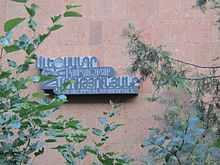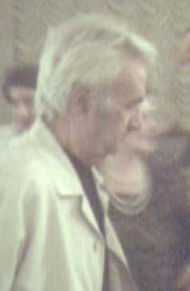Alexander Arutiunian
| Alexander Arutiuniuan | |
|---|---|
|
Arutiunian in 2008 in Yerevan | |
| Background information | |
| Birth name |
Alexander Grigori Harutyunyan Ալեքսանդր Գրիգորի Հարությունյան |
| Born |
23 September 1920 Yerevan, Democratic Republic of Armenia |
| Died |
28 March 2012 (aged 91) Yerevan, Armenia |
| Genres | Classical music |
| Occupation(s) | Composer, Pianist |
| Years active | 1920s-2012 |
| Website | http://www.alexanderarutiunian.com/ |
Alexander Grigori Arutiunian (Armenian: Ալեքսանդր Գրիգորի Հարությունյան), also known as Arutunian, Arutyunyan, Arutjunjan or Harutiunian (23 September 1920 – 28 March 2012), was a Soviet/Armenian composer and pianist, widely known for his 1950 trumpet concerto.[1] A professor at Yerevan State Conservatory, he was recognized with many awards for his work, including the Stalin Prize in 1949 and People's Artist of the USSR in 1970, as well as numerous honors from his homeland of Armenia.[2]
Biography
Arutiunian was born in Yerevan, Armenia, in the family of Grigor and Eleonora Arutiunian. His father was a military serviceman. At an early age Arutiunian met famous composer Alexander Spendiarian. In 1927 Arutiunian became a member of the Yerevan State Conservatory’s children group, then, at the age of fourteen, he was admitted to the Conservatory to the studios of Olga Babasyan (piano), and Sergei Barkhudaryan and Vardges Talyan (composition). He graduated from the Music Conservatory of Yerevan on the eve of World War II. After the war he moved to Moscow, where between 1946 and 1948 he participated in the workshops of House of Armenian Culture, studied composition with Genrikh Litinsky. After graduation he returned to Yerevan to teach at the local Conservatory and in 1954 he was appointed artistic director of the Armenian State Philharmony. He was also a member of the Board of the USSR Composers' Union, as well as of the Armenian SSR Composers’ Union.
In 1948 he was awarded the Stalin Prize for the Motherland cantata, a graduation piece he wrote as a student at the Moscow Conservatory. The USSR Radio Choir and Orchestra performed this work first time in November 1948.
In 1949, Arutiunian composed the "Festive Overture" that was first performed in the Big Hall of the Leningrad Philharmonic in November 1949, with Evgeny Mravinsky conducting. During the Moscow Music Congress Aram Khachaturian considered him as a promising Soviet composer.[3] He has continued to win acclaim at home and abroad for his works, many of which are quickened by the folk traditions of Armenian music. Other works of that kind include The tale of Armenian people (1960), Ode to Lenin (1967) and Hymn to the brotherhood (1970).
Some of Arutiunian's works for wind instruments, notably the 1950 concerto for trumpet, the concerto for tuba, and the brass quintet Armenian Scenes, have secured their place in the international repertory, having been performed by conductors such as Valeri Gergiev, who has recorded his Symphony for large orchestra (composed in 1957) with the Symphony orchestra of the Russian All-Union Radio.
"Simfonietta" for string orchestra in four movements (1966, dedicated to the Armenian Chamber Orchestra) is another innovative work by Arutiunian. Dmitri Shostakovich described it as "wonderfully clean, and pure", with an "excellent choice of themes".[4]
In 1988, inspired by the Spitak earthquake, Arutiunian composed the Concerto for Violin and String Orchestra (dedicated to Ruben Aharonyan). One of the composer’s most emotionally exposed compositions, here the main principles of his compositional style are undoubtedly preserved, with deep psychological involvement and philosophical insight. The 4-movement cycle is organized according to the scheme: slow first and third movements, and faster second and fourth movements. "...The Concerto overflows with graceful melodic invention, rhythmic vitality, deeply-felt emotional intensity especially in the central third movement, and dionysiac exuberance in the sparkling final perpetuum mobile...", wrote Joseph Horovitz.[4] The premiere took place in Yerevan in 1989.
In September 2010 Arutiunian's 90th birthday was celebrated by a series of concerts.
Trumpet Concerto in A-flat major (1950)
Arutiunian's Trumpet Concerto consists of the following movements:
- Andante—Allegro energico
- Meno mosso
- Tempo I
- Meno mosso
- Tempo I - (Cadenza) Coda
The melodic and rhythmic characteristics of Armenian folk music are a strong influence in Arutiunian’s work. As a composer, he expresses his nationality by incorporating the flavor of ashughner (folk minstrel) improvisations. At the time the concerto was written, his compositional style was similar to Khachaturian's. However, in the 1960s he tended towards classical forms and clearer tonality.
Arutiunian’s trumpet concerto was his sixth major composition, written in 1950. Arutiunian originally intended to write it in 1943 for a student of Tabakov, Zsolak Vartasarian, who was the principal trumpet in the Armenian Philharmonic Orchestra. However, Vartasarian died in the war and the concerto was not completed until 1950, so Aykaz Messlayan was the first performer of the Concerto and Timofei Dokschitzer was the first recording artist of this concerto."[5]
The concerto's introduction to the United States is solely due to Dokschitzer, a leading Soviet Russian trumpeter.
Personal life

In 1950 Arutiunian married Irina (Tamara) Odenova. They have a daughter, Narine (born 1951), who is a pianist and lawyer; and a son, Suren (born 1953), who is an artist-designer. Arutiunian has 3 granddaughters and a grandson.
He died, aged 91, in his home city of Yerevan.[6]
Alexander Arutiunian is buried at the Komitas Pantheon which is located in the city center of Yerevan. [7]
Awards
- 1949 - State Stalin Prize (USSR State Prize)
- 1962 - People's Artist of Armenia
- 1970 - People's Artist of USSR
- 1972 - State Prize of Armenia
- 1977 - All-Union Alexandrov Prize (Gold medal)
- 1983 – Orpheus Award (USA)
- 1986 - Aram Khachaturian Prize
- 1998 – "Khorenatsi" Medal (Armenia)
- 2001 - "St Mesrop Mashtots" Order (Armenia)
- 2004 - St Sahak and St Mesrop Order (Etchmiadzin, Armenia)
- 2005 - Armenian Academy of Sciences Gold Medal
- 1983 - Honorary Citizen of the State of Kentucky, USA
- 1987 - Honorary Citizen of Yerevan City.
Main performers of Arutunian's compositions
- Conductors: Valery Gergiev, Yevgeny Mravinsky, Ohan Durian, Konstantin Orbelyan, Gennady Rozhdestvensky, Mstislav Rostropovich, Yevgeny Svetlanov, Loris Tjeknavorian, Karl Eliasberg, Vladimir Fedoseyev, Aram Gharabekyan, David Khanjyan, Konstantin Sarajev, Vladimir Spivakov, Daniel Lipton etc.
- Choirmasters: Tatul Altunyan, Hovhannes Chekijyan
- Pianists: Şahan Arzruni, Svetlana Navasardyan
- Violinists: Ilya Grubert, Ruben Aharonyan
- Cellists: Mstislav Rostropovich, Daniil Shafran, Geronty Talalyan
- Trumpeters: Timofei Dokschitzer, Maurice André, Eric Aubier, Philip Smith, Roger Voisin, Ibrahim Maalouf, Maurice Murphy, David Hickman, Sergei Nakariakov, Carolina Brass, Alison Balsom, Marco Pierobon, Philippe Schartz, Rod Franks, James Watson, Tine Thing Helseth etc.
- Flutists: James Strauss, Alexander Korneyev
- Vocalists: Irina Arkhipova, Zara Dolukhanova, Lili Chookasian, Gohar Gasparyan, Pavel Lisitsian, Lusine Zakaryan, Vladimir Zakharov and others.
Works
Important works include:
- 1946 Polyphonic Sonata in 3 movements;
- 1948 Cantata about the Motherland for soloist, choir and symphony orchestra in 5 movements (words by Ashot Grashi and Sarmen);
- 1949 Festive Overture for symphony orchestra;
- 1950 Concerto for trumpet and symphony orchestra (dedicated to Haykaz Mesiayan);
- 1950 Armenian Rhapsody (co-author: Arno Babajanyan)
- 1951 Concertino for piano and symphony orchestra in 3 movements (dedicated to Arutiunian's daughter, Narine)
- 1952 Armenian Dances for symphony orchestra in 5 movements
- 1955 Concert Scherzo for trumpet and symphony orchestra
- 1957 Symphony in 4 movements (dedicated to Tamara Odenova, spouse and friend)
- 1957 Armenian Fantasy for pops band (co-author: Konstantin Orbelyan)
- 1960 A Legend about the Armenian People vocal-symphonic poem in 4 movements (words by Ashot Grashi)
- 1964 Concerto-Fantasy [5 Contrasts] for wind quintet and symphony orchestra
- 1966 Sinfonietta for string orchestra in 4 movements
- 1969 Sayat-Nova, opera in three acts, libretto: H.Khanjyan
- 1973 Theme with Variations for trumpet and symphony orchestra
- 1980 Concerto for flute and string orchestra in 2 movements;revised in 2009 with a new cadenza and dedicated to James Strauss
- 1984 Armenian Sketches suite for brass quintet in 4 movements
- 1986 Sasuntsis’ dance for string quartet and piano (arrangement)
- 1988 Concerto for violin and string orchestra in 4 movements (dedicated to Ruben Aharonyan)
- 1989 Dance for four trombones
- 1990 Rhapsody for trumpet and pops band
- 1991 Concerto for trombone and symphony orchestra in 3 movements (dedicated to Michel Beke)
- 1992 Concerto for tuba and symphony orchestra in 3 movements (dedicated to Roger Bobo)
- 1998 Suite for oboe, horn and piano in 3 movements
- 2004 Children's Album for piano
Filmography
Music for Films
- Nahapet (1977) (as Life Triumphs in USA)
- Za chas do rassveta (An Hour Before the Dawn, 1973, TV)
- Sirtn e yergum (The Heart Sings, 1957)
- Urvakannere heranum en lernerits (Ghosts Leave the Peaks, 1955)
- Aleph, lectures contades (2000) Italian TV episode (soundtrack: "Concerto for trombone and orchestra")
As Actor
- Lalvari vorskane (Lalvar Hunter, 1967) as Zako
Bibliography
Autobiography
- Alexander Arutiunian Memoirs, Yerevan, 2000 (in Armenian and Russian)
Monographs about Alexander Arutiunian
- Izabella Rubenovna Yolyan, Alexander Arutiunian, Moscow: Sovetskii Kompozitor, 1962 (in Russian)
- Mikhail Artemovich Kokzhayev, The stylistic peculiarities of Alexander Arutiunian’s compositions, Moscow: Kompozitor, 2006 (in Russian)
Dictionary articles
- Arutiunian, Alexander by Don Michael Randel, in 'The Harvard concise dictionary of music and musicians', 1999, 757 pages, p. 36
- Alexander Arutiunian in Great Soviet Encyclopedia
References
- ↑ CLASSICAL MUSIC AND DANCE GUIDE, The New York Times, August 4, 2000
- ↑ Arutiunian, Alexander, The International Who's Who, Europa Publications, 2004, p. 69
- ↑ Moscow Music Congress, Time (magazine), April 15, 1957
- ↑ 4.0 4.1 Alexander Arutiunians official site, Review
- ↑
- ↑ Norman Lebrecht. "Tributes to an Armenian legend". Arts Journal. Retrieved 29 March 2012.
- ↑ Arutiunian's memorial tombstone at Komitas Pantheon
External links
- Official Site
- List of works
- Arutunian at IMDB
- Alexander Arutiunian. Celebrations of his 85th anniversary, By Jean-Pierre Mathez, "Brass Bulletin", 2005
|
